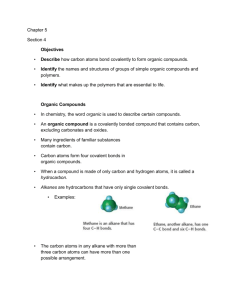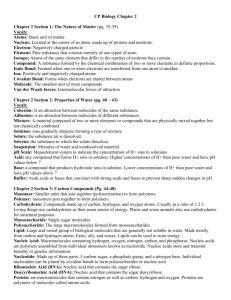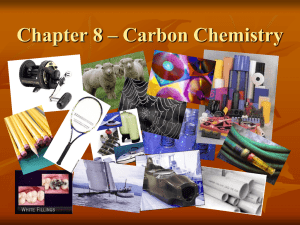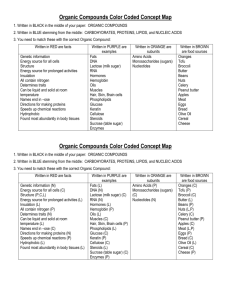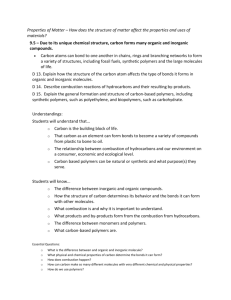Ch - Central Lyon CSD
advertisement
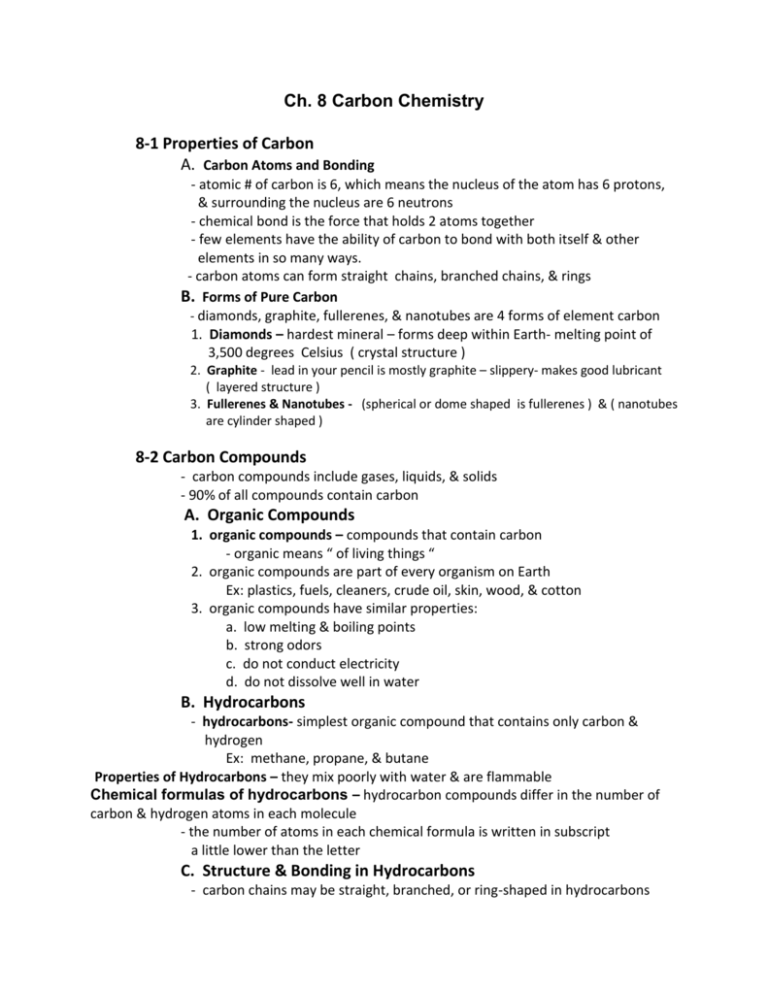
Ch. 8 Carbon Chemistry 8-1 Properties of Carbon A. Carbon Atoms and Bonding - atomic # of carbon is 6, which means the nucleus of the atom has 6 protons, & surrounding the nucleus are 6 neutrons - chemical bond is the force that holds 2 atoms together - few elements have the ability of carbon to bond with both itself & other elements in so many ways. - carbon atoms can form straight chains, branched chains, & rings B. Forms of Pure Carbon - diamonds, graphite, fullerenes, & nanotubes are 4 forms of element carbon 1. Diamonds – hardest mineral – forms deep within Earth- melting point of 3,500 degrees Celsius ( crystal structure ) 2. Graphite - lead in your pencil is mostly graphite – slippery- makes good lubricant ( layered structure ) 3. Fullerenes & Nanotubes - (spherical or dome shaped is fullerenes ) & ( nanotubes are cylinder shaped ) 8-2 Carbon Compounds - carbon compounds include gases, liquids, & solids - 90% of all compounds contain carbon A. Organic Compounds 1. organic compounds – compounds that contain carbon - organic means “ of living things “ 2. organic compounds are part of every organism on Earth Ex: plastics, fuels, cleaners, crude oil, skin, wood, & cotton 3. organic compounds have similar properties: a. low melting & boiling points b. strong odors c. do not conduct electricity d. do not dissolve well in water B. Hydrocarbons - hydrocarbons- simplest organic compound that contains only carbon & hydrogen Ex: methane, propane, & butane Properties of Hydrocarbons – they mix poorly with water & are flammable Chemical formulas of hydrocarbons – hydrocarbon compounds differ in the number of carbon & hydrogen atoms in each molecule - the number of atoms in each chemical formula is written in subscript a little lower than the letter C. Structure & Bonding in Hydrocarbons - carbon chains may be straight, branched, or ring-shaped in hydrocarbons 1. 2. 3. 4. - 2 or more atoms form straight line - 4 or more branched or straight Structural Formulas – shows the kind, number, & arrangement of atoms in a molecule Isomers – compounds that have the same chemical formula but different structural formulas - each isomer is a different substance with its own characteristic property Double Bonds & Triple Bonds- in addition to forming a single bond carbon atoms can form double or triple bonds – double bonds have double dashes & triple bonds are shown with triple dashes Saturated & Unsaturated Hydrocarbons - saturated hydrocarbons- each carbon atom is filled up with hydrogens - hydrocarbons ending in –ane are saturated - unsaturated hydrocarbons- have fewer hydrogen atoms for each carbon atom - hydrocarbons ending in – ene or –yne are unsaturated - many fruits produce ethane gas D. Substituted Hydrocarbons -if 1 atom of another element id substituted for a hydrogen atom in a hydrocarbon, a different compound is made - substituted hydrogen- atoms of other elements replace 1 or more hydrogen atoms in a hydrocarbon 1. Compounds Containing Halogens Ex: chlorine, bromine, iodine, & Freon, which is now banned from use 2. Alcohols- a substituted hydrocarbon that contains 1 or more hydroxyl - hydroxyl group- OH , made of oxygen atoms & hydrogen atoms - ethanol- an alcohol produced naturally by the action yeast or bacteria on the sugar stored in corn, wheat, or barley - added to gasoline & used in medicines 3. Organic Acids- substituted hydrocarbon that contains 1 or more carboxyl groups - carboxyl group written as COOH E. Esters - Ester- a compound made by chemically combining an alcohol and an organic acid ( have pleasant fruity smell) F. Polymers - polymer- a very large molecule made of a chain of many smaller molecules boned together ( “poly” means many ) - monomers- smaller molecules ( “mono” means one ) - some polymers are made by living things (Ex: sheep grow wool) while others are synthetic polymers, made in factories 8-3 Polymers & Composites - polymer is a large complex molecule built from smaller molecules joined together in a repeating pattern A. Forming Polymers - food materials, living things, & plastic are all made of organic compounds 1. Carbon Chains & Rings - carbon atoms can form 4 convalent bonds - carbon atoms can bond in straight & branched chains or ringshaped 2. Carbon Compounds & Polymers - polymers are formed when chemical bonds link large numbers of monomers in a repeating pattern B. Polymers & Composites 1. Natural Polymers Ex: cellulose, snake venom, & spider’s silk - cellulose is found in fruits & vegetables - proteins- formed from smaller molecules called amino acids - amino acid- a monomer that is a building block of proteins 2. Synthetic Polymers - many polymers you use everyday are synthesizedwhich means made from simpler materials - Ex: plastics, carpet, glue, & chewing gum ( page 277 ) 3. Comparing Polymers – synthetic polymers are used in place of natural materials that cost too much or wear out too fast 4. Composites- combines 2 or more substances in a new material with different properties - many composite materials include 1 or more polymer - common natural composite is wood -The development of polymers : 1839 synthetic rubber 1869 celluloid 1909 bakelite 1934 nylon 1971 kevlar 2002 light-emitting polymers 5. Uses of Composites – many useful composities are made from strong polymers combined with lightweight ones. Ex: fiberglass, bikes, fishing rods, & sporting equipment. C. Too Many Polymers? - synthetic polymers are inexpensive to make, strong, & last a long time - A disadvantage of using synthetic polymers is that it is cheaper to throw plastics away & make new than it is to reuse them. Therefore it increases the amount of trash - plastics don’t break down. - to ease this problem we need to recycle the plastics 8-3 Life With Carbon -foods provide organic compounds, which the cells of living things use, change, or store. - four classes of organic compounds required by living things : carbohydrates, proteins, lipids, & nucleic acids A. Carbohydrates – energy – rich organic compound made of the elements carbon, hydrogen, & oxygen - carbohydrate means “ combined with water “ 1. Simple Carbohydrates - simplest are sugars - glucose- one of the most important sugars in your body. Called “ blood sugar “ because your body circulates glucose to all parts of your body through your blood. - the sugar that we are familiar with is sucrose 2. Complex Carbohydrates - have larger molecules than simple carbohydrates - Complex Carbohydrate - polymer made of smaller molecules that are simple carbohydrates bonded to one another - Starch & Cellulose are polymers built from glucose ( their molecules are arranged differently so they are different compounds ) 3. Starch- plants store energy in the form of this complex carbohydrate 4. Cellulose- complex carbohydrate found in plant stems : fruits, vegetables, & grains are high in cellulose B. Proteins - muscles, hair, skin, and fingernails are all made from protein - amino acids are the building blocks of proteins 1. Chains of Amino Acids - 20 kinds of amino acids found in living things - different proteins are made when different sequences of amino acids are linked into long chains 2. Food proteins become your proteins - good sources of protein are : meat, eggs, milk, and beans C. Lipids – energy rich compounds made of carbon, oxygen, & hydrogen. - release twice as much energy in your body as do carbohydrates 1. Fats and Oils - fats & oils have the same basic structure , each are made from 3 fatty acids & 1 alcohol, glycerol fatty acid- organic compound that is a monomer of fat or oil 2. Cholesterol – a waxy substance found in all animal cells - excessive amounts of cholesterol can lead to heart disease D. Nucleic Acids – a very large organic molecule made up of carbon, oxygen, hydrogen, nitrogen, and phosphorus - DNA –deoxyribonucleic acid - RNA –ribonucleic acid 1. Nucleotides – building blocks of nucleic acids 2. DNA and Proteins - The differences among living things depend on the order of nucleotides in their DNA - proteins regulate all cell activity - living things differ because their DNA and proteins differ from others - when reproducing you pass DNA to the next generation E. Other Compounds in Foods - your body needs vitamins, minerals, water, & salts 1. Vitamins –organic compounds that serve as helper molecules in your body 2. Minerals- elements in the form of ions in your body ( not organic ) 3. Water – not organic but something you need to survive - water makes up most of body fluid and 90% of your blood
